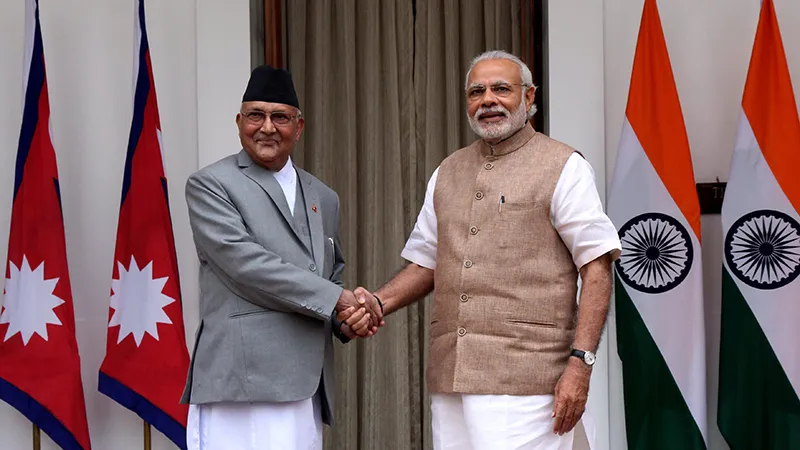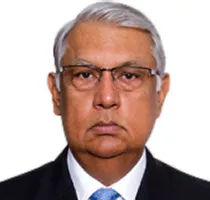The recent visit of Nepal’s Prime Minister K.P. Sharma Oli to India was the first serious opening move to grapple with issues that have soured bilateral relations for some time, between two of South Asia’s closest neighbours. India and Nepal have enjoyed a relationship that has not been replicated by any two countries anywhere in the world. The majority of the people of both countries share Hinduism as their religion and this unique relationship has been based on an open border. Indians and Nepalese have moved freely across the shared border settling down both sides, as if they were one people. The relationship has often been described as “roti-beti ka sambandh”.
Nepalese nationals have served in the Indian Army since the days of the British Raj. That bond between soldiers of the two countries continues and there is little doubt that India has mandated a close alignment of Foreign and Defence policies between the two countries. After the formation of Nepal’s new Constituent Assembly, calls for revoking the 1950 Treaty have been raised by the ruling elite to increase leverage with India.
PM Oli’s message, while embarking on his visit to India, emphasised the further strengthening of “historic bilateral ties”. He was careful also to underline for his home constituency that he would undertake his task based on the “principles of equality, mutual respect and benefit”. He also announced that a high level committee will be set up to examine provincial boundaries, a source of much of the domestic agitation regarding the disputed new Constitution adopted by Nepal. Such balancing of statements is par for the course, given the background of turbulence in India-Nepal relations over the last several months since the adoption of the new Constitution by Nepal.
PM Oli is no spring chicken in Nepal’s politics. Ideologically, he has moved from the extreme left to the less extreme Communist Party (UM-L) after multi-party democracy emerged in Nepal. In his long political career, he has held positions of Home Minister and Foreign Minister and developed an image as a savvy politician. Notwithstanding PM Oli’s friendship with many Indian leaders, developed over the years, his pitch for the PM’s job after the new Constitution came into effect, led to some estrangement. Unsympathetic to the unfulfilled demands of the Madhesis, on issues like federalism and proportional representation, Oli and his UM-L Party were at odds with Indian suggestions for consensus building which favoured accommodation of Madhesi aspirations in the new Constitution.
The passage of the new Constitution cast the die for the subsequent domestic turmoil. Oli also felt cheated because the NC did not support his candidature for PM and re-nominated the recently deceased Sushil Koirala again as the PM candidate. Oli sensed an Indian hand in denying him the nomination. In the end he managed to garner support from other Maoists to clinch the position of PM in October, 2015.
Confronted with the Madhesi agitation which led to clashes with the security forces and over 50 deaths, PM Oli accused India of fanning the flames of Madhesi agitation and imposing a “blockade” on his landlocked country. India kept on urging him to find a political resolution, to ensure security for movement of goods by trucks. Madeshi agitators had stopped all movement by squatting on roads that serve as the supply conduits from India into Nepal.
Somewhat brashly, PM Oli also overplayed the China card and fanned a parochial version of Nepali nationalism, to blame India and deflect attention from the real issue of domestic political discord over the new Constitution. There were leaked reports of PM Oli opting for visiting China first though any new PM of Nepal has always made Delhi the first port of call. Unfortunately, none of these gambits worked – China could not replace India as the major supplier of goods over a harsh and difficult terrain across the Nepal-Tibet border. China, moreover, after promising some supplies of fuel, realised that it was not in its geopolitical interest to goad Nepal into more anti-Indian posturing.
The Madeshi agitation caused immense hardship to the Nepalese population with the Oli government caught between a rock and a hard place, without a viable and placatory route out of the crisis. Meanwhile, the Madeshi agitation started seeding troubling demands for an independent Madhes. PM Oli resisted suggestions for amending the Constitution and resorted to the rusty strategy of blaming India for interfering in his country’s internal affairs which provoked anti-India sentiments among the elite and Nepal’s power brokers. Further complicating this situation were hints and leaks that the NDA government in Delhi was stoking the fire of Madhesi agitation to influence the state Assembly election in Bihar. The Madhesi people are basically from Bihar and Uttar Pradesh, two of India’s most populous provinces, who have settled in the Terai region of Nepal and have close family links with their brethren across the border in India.
The rollercoaster in ties peaked during Indian PM Modi’s visit to Nepal in August 2014 and India’s overwhelming support to Nepal in the aftermath of the devastating earthquake in April 2015 to the low point, prior to PM Oli’s visit to India. Nepali leaders who were in favour of making concessions to the Madhesis were left isolated in the polarised political climate deliberately encouraged and promoted by the Oli government and its allies.
There was only one way out of this impasse – a pragmatic approach that would need some crucial amendments to the Constitution. PM Oli’s Foreign Minister’s two visits to Delhi helped hammer out a compromise and India started cooperating in ensuring movement of supplies into Nepal. The Madeshi Morcha (Front) saw the writing on the wall, realising that the agitation had reached the dead end.
Nepal has paid a heavy cost for its inability to manage its domestic political discourse at a time when the highest national priority has been the reconstruction effort after the earthquake. Nepal’s growth rate is likely to be near zero, despite the availability of funding for the reconstruction work from foreign sources. India has already committed around USD 2 billion for the reconstruction programme.
The time for healing is now. PM Oli’s trip may not have salvaged everything but the overall purpose of restoring a balance has been achieved, setting aside the drift that had marked bilateral ties since the adoption of the new Constitution. PM Oli was honest in acknowledging that “in the last few months there have been many misunderstandings between our two countries…….We now want to get our relationship back on track.”
The week-long visit by PM Oli may not have set the Ganga ablaze and differences over the constitutional crisis have not abated. No joint statement was issued after the summit, indicating lack of convergence on the Constitutional amendment issue. The ball remains in Nepal’s court to resolve the Constitutional crisis which can only be put to rest by following through with the necessary amendments that have been promised. Overall, the visit has helped PM Oli to strengthen his political position back home. India too has navigated the crisis giving Oli the space to deliver on the promises made and sending an unambiguous message that Nepal’s ties with India is a matter of strategic concern for Delhi, given that the two countries are geographically locked in a close embrace with a 1800 km open and undefended shared border. India cannot have a hostile government in Kathmandu that starts flirting with options that undermine India’s security.
This commentary originally appeared in Daily Sun.
The views expressed above belong to the author(s). ORF research and analyses now available on Telegram! Click here to access our curated content — blogs, longforms and interviews.




 PREV
PREV


